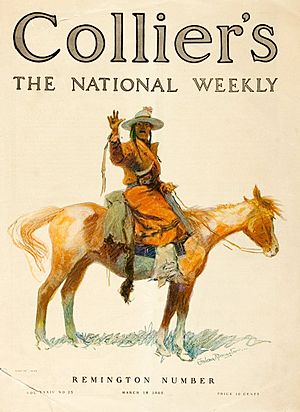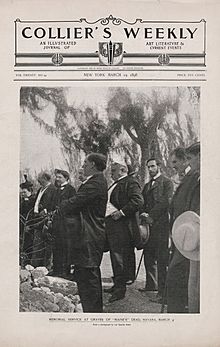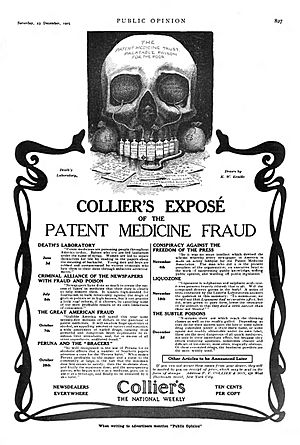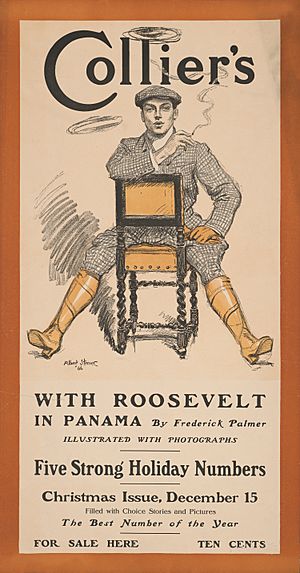Collier's facts for kids

Cover illustration by Frederic Remington (March 18, 1905)
|
|
| Founder | Peter Fenelon Collier |
|---|---|
| First issue | April 28, 1888 |
| Final issue | January 4, 1957 |
| Country | United States |
| Based in | Springfield, Ohio |
| Language | English |
| ISSN | 2161-6469 |
Collier's was a popular American magazine that started in 1888. It was created by Peter Fenelon Collier. The magazine went by a few different names over the years, like Collier's Once a Week and Collier's Weekly. Eventually, it was known simply as Collier's. The magazine stopped being published in 1957.
Collier's became famous for its special kind of reporting called investigative journalism. This meant they dug deep to find out the truth about important issues. Because of this, Collier's became known for pushing for social changes and improvements. Other magazines soon followed their lead. This type of journalism was even called "muckraking" by President Theodore Roosevelt. To honor Peter Collier's work, a special award called the Collier Prize for State Government Accountability was created in 2019. It's one of the biggest journalism awards in America.
Contents
History of Collier's Magazine
Peter F. Collier, who started the magazine, came to the U.S. from Ireland when he was 17. He first worked selling books. He later decided to start his own business selling books by subscription. This meant people could sign up to get books delivered regularly. His company, P. F. Collier & Son, became very successful. It sold millions of books.
In 1888, Peter Collier launched Collier's Once a Week. It was a magazine filled with stories, facts, humor, and news. It quickly became one of the most popular magazines in the United States. By 1892, over 250,000 copies were sold each week!
The magazine changed its name to Collier's Weekly in 1895. It focused a lot on news and used new technology to print clear news pictures. They even hired Jimmy Hare, who was a pioneer in photojournalism. This meant he was one of the first to use photos to tell news stories.
Peter Collier's son, Robert J. Collier, joined the business in 1898. The magazine became known as Collier's: The National Weekly by 1904. After Peter Collier passed away in 1909, Robert continued to run the magazine.
In 1919, the magazine was sold to the Crowell Publishing Company. Later, in 1924, the printing of the magazine moved from New York to Springfield, Ohio. The editorial and business offices stayed in New York. The printing plant in Ohio was very large, with many buildings.
Amazing Stories and Authors
Collier's was known for its "short-short stories." These were often planned to fit on just one page. Many famous authors wrote for Collier's. Some of them include F. Scott Fitzgerald, Ray Bradbury, Willa Cather, Roald Dahl, J. D. Salinger, and Kurt Vonnegut.
The magazine also published novels in parts, called serials. Sometimes, they would even run two novels at the same time! Between 1913 and 1949, the Fu Manchu stories by Sax Rohmer were very popular. These stories were often put together from shorter pieces Rohmer wrote for Collier's.
For example, The Mask of Fu Manchu was first published as a 12-part story in Collier's in 1932. The cover for the May 7, 1932, issue featured a memorable mask design by Władysław T. Benda. This design was later used by many other artists.
Talented Illustrators
Many top artists created amazing covers and illustrations for Collier's. Some of these famous illustrators included C. C. Beall, W.T. Benda, Chesley Bonestell, Howard Chandler Christy, James Montgomery Flagg, Charles Dana Gibson, Maxfield Parrish, and Frederic Remington.
In 1903, Charles Dana Gibson signed a huge contract with Collier's. He agreed to create 100 pictures for $1,000 each! From 1904 to 1910, Maxfield Parrish worked only for Collier's. During this time, he created his famous Arabian Nights paintings.
Investigative Reporting
When Norman Hapgood became the editor of Collier's in 1903, he brought in many great writers. He asked Jack London to report on the 1906 San Francisco earthquake. This report included 16 pages of pictures. Under Hapgood's leadership, Collier's started publishing the work of investigative journalists like Samuel Hopkins Adams and Ida Tarbell.
Their reporting had a big impact. It helped bring about changes like new child labor laws, improvements in poor city areas, and women's suffrage (the right for women to vote). In 1905, an article by Upton Sinclair about dirty meat in Chicago helped lead to the Federal Meat Inspection Act in 1906.
One very important series was "s:The Great American Fraud" by Samuel Hopkins Adams, which started in 1905. Adams looked closely at popular "patent medicines." He showed that companies were making false claims about their products. Some of these products were even dangerous!
"The Great American Fraud" had a huge effect. It helped lead to the first Pure Food and Drug Act in 1906. This law made sure that food and medicines were safe and honestly labeled. The entire series of articles was even reprinted as a book.
Hapgood's work greatly influenced public opinion. Between 1909 and 1912, he doubled the number of Collier's readers from half a million to a million! Later, famous writers like Martha Gellhorn and Ernest Hemingway reported on the Spanish Civil War for the magazine. Even Winston Churchill wrote articles for Collier's in the 1930s.
Funny Cartoonists
Collier's featured many top cartoonists. Some well-known names included Charles Addams, Carl Anderson, Stan and Jan Berenstain, Jack Cole, Crockett Johnson, Hank Ketcham, Bill Mauldin, and William Steig.
Kate Osann's Tizzy cartoons first appeared in Collier's. Tizzy was a redheaded teenage girl with unique triangular glasses. After Collier's closed, the Tizzy cartoons were still published in newspapers.
After World War II, Harry Devlin became the main editorial cartoonist for Collier's. His cartoons were special because they were in full color. During the 1940s, Gurney Williams was the cartoon editor. He looked through about 2,000 cartoon ideas every week!
Collier's on the Radio
To compete with other magazines, Collier's started its own radio show called The Collier Hour. It was broadcast from 1927 to 1932. This was one of the first big drama shows on radio. It turned stories and serials from the magazine into radio plays. The show also started including music, news, sports, and comedy.
Later Years and Closing
During World War II, Collier's had a huge number of readers, reaching 2.5 million. In 1944, the magazine published one of the first articles about concentration camps. It was a powerful account by Jan Karski about his visit to Belzec.
After World War II, the magazine started to lose readers. However, Collier's still published some amazing articles. In the early 1950s, they ran a series of articles about space travel called Man Will Conquer Space Soon!. These articles helped more Americans believe that a trip to the moon could actually happen.
In 1951, an entire issue of Collier's imagined what would happen in a hypothetical war between the United States and the Soviet Union. The magazine changed from being published every week to every two weeks in 1953, but it continued to lose money.
Collier's stopped publishing with its issue dated January 4, 1957. The cover of that final issue featured Princess Grace of Monaco.
Books and Collections
The company that published Collier's magazine also published other things. They created the Collier's Encyclopedia, Collier Books, and the Collier's Year Book.
Several books were also made from the magazine's content. For example, Over 100 Best Cartoons from Collier's collected many of the funny drawings. There was also Collier's Kids: Cartoons from Collier's About Your Children.
Knox Burger, who was the fiction editor for Collier's, chose 19 stories for a book called Collier's Best. A large history and collection of the magazine's work, called A Cavalcade of Collier's, was published in 1959.
Quick Facts About Collier's
Magazine Titles Over Time
- Collier's Once a Week (1888-1889)
- Once a Week, an Illustrated Weekly Newspaper (1889-1895)
- Collier's Weekly, an Illustrated Journal (1895-1904)
- Collier's, The National Weekly (1905-1957)
First and Last Issues
- First Issue: April 28, 1888
- Last Issue: January 4, 1957
How Often It Was Published
- Weekly (1888-1935)
- Fortnightly (every two weeks) (1953-1957)
Publishers of the Magazine
- P.F. Collier, New York (1888-1900)
- P.F. Collier and Son, New York (1900-1919)
- P.F. Collier & Son Company (1919-1934)
- Crowell Publishing Company (1934-1939)
- Crowell-Collier Publishing Company (1939-1957)
Editors of Collier's
- Nugent Robinson (1888-1890)
- Mayo Williamson Hazeltine (1891)
- Julius Chambers (1892-1893)
- T.B. Connory (1893-1896)
- Daniel Lyons (1896-1898)
- Robert Joseph Collier (1898-1902)
- Norman Hapgood (1902-1913)
- Mark Sullivan (1913-1917)
- Finley Peter Dunne (1917-1919)
- Harford Powel Jr. (1919-1922)
- Richard J. Walsh (1922-1924)
- Loren Palmer (1924-1925)
- William L. Chenery (1925-1943)
- Charles Colebaugh (1943-1944)
- Henry La Cossitt (1944-1946)
- Walter Davenport (1946-1949)
- Louis Ruppel (1949-1952)
- Roger Dakin (1952-1955)
- Kenneth McArdle (1955-1957)
- Paul Clifford Smith, editor-in-chief, (1954-1957)









